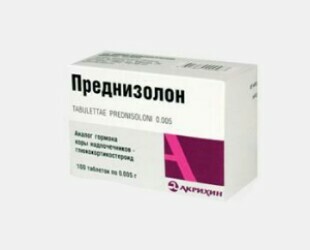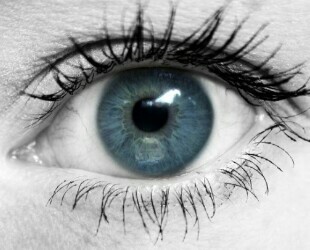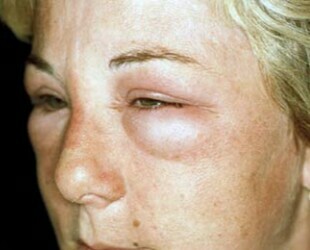
Prednisolone is a medical preparation that is a synthetic analogue of such hormones as hydrocortisone and cortisone.
They are known to excrete the adrenal cortex.
Ingestion Prednisolone has four to five times more activity than cortisone, and it is three to four times stronger than hydrocortisone.
However, it differs from these hormones in that it only slightly increases the release of potassium and does not provoke the accumulation of fluid and sodium in the organs. This drug will be considered in more detail, given that it is often prescribed in ophthalmology.
- 1. Instructions for use
- 2.
- side effects 3.
- storage terms and conditions 4.
- price 5.
- analogues 6.
- reviews 7.
- conclusion 8. Useful video
Instruction for use
Prednisolone is characterized by anti-inflammatory, antihistaminic, antishock, antiexudative and antitoxic action.
Indications for use
Prednisolone is characterized by a very wide range of applications. It is prescribed for the treatment of endocrine system diseases such as:
- Primary and secondary, as well as acute, insufficiency of the adrenal cortex.
- Adrenogenital syndrome.
- Thyroiditis in subacute form.
This drug is also used in the preparation for surgery in patients who suffer from adrenal insufficiency, as well as in complex diseases and injuries in such patients.
Prednisolone is prescribed to get rid of serious ailments of an allergic nature that do not go away with the treatment with other drugs. To such ailments is:

- Serum disease.
- Atopic and contact form of dermatitis.
- A regular or seasonal runny nose caused by allergies.
- Manifestations of excessive susceptibility to drugs
- Angioedema.
- Anaphylactoid.
With the help of prednisolone, rheumatic diseases such as:
- common and juvenile arthritis of rheumatoid type can be treated;
- is psoriatic and acute gouty arthritis;
- ankylosing spondylitis;
- myocarditis;
- rheumatic fever during exacerbation;
- nodular variety of periarteritis;
- scleroderma of the systemic type.
- rheumatic polymyalgia, which is called Horton's disease;
- polychondritis in the stage of relapse;
- systemic vasculitis.
This drug is used to treat liver diseases such as active hepatitis in chronic form and alcohol-type hepatitis with encephalopathy.
Prednisolone is prescribed and to individuals with an overabundance of calcium in the body with sarcoidosis or poor-quality formations.
Prednisolone may also be prescribed in the treatment of such dermatological diseases as:
- pemphigus;
- exfoliative dermatitis;
- seborrhoeic and bullous dermatitis of herpetic form;
- pemphigoid;
- complex forms of eczema;
- complex erythema multiforme or Stevens-Johnson syndrome;
- mycosis mushroom type.
This medicine is also used to get rid of the following inflammatory processes in the joints:
- Bursitis in acute and subacute stage.
- Osteoarthritis after trauma.
- Epicondylitis.
- Tendovaginitis.
Prednisolone is treated with hematologic diseases such as:
- of hemolysis;
- aplastic anemia of the congenital type;
- of Vergolf's disease or idiopathic thrombocytopenic purpura;
- of sudden autoimmune hemolytic anemia.
The above medicament is also used in the treatment of the following oncological diseases:
- Lymphoma.
- Tumor of the mammary glands.
- Leukemia is both acute and chronic.
- Prostate cancer.
- Extended myeloma.
In practice, ophthalmologists Prednisolone can be used to get rid of complex inflammatory and allergic manifestations in acute and chronic form, which include:
- Inflammation of the optic nerve. Symptomatic ophthalmic.
- Complicated sluggish posterior or anterior uveitis.
In neurology, the aforementioned drug is used for therapy during such ailments:
- multiple sclerosis at the stage of exacerbation;Myasthenia gravis
- ;
- is a tuberculosis-type meningitis with a subarachnoid block;
Prednisolone beneficially affects patients with respiratory problems such as bronchial asthma, Leffler's syndrome, berylliosis, symptomatic sarcoidosis, chronic pulmonary emphysema and pulmonary tuberculosis.
It is also used to get rid of pericarditis. It is recommended that this medication also be used for the transplantation of tissue or organ sites in order to prevent the reaction of non-acceptance of the transplant.
Form release, composition
The above medication can be found on sale in various forms:
- Tablets with a content of 0.001, 0.005, 0.02 or 0.05 grams of prednisolone, as well as gelatin, lactose, magnesium stearate and potato starch. They have a white or whitish coloration, a rounded shape without convexity, a facet and an inscription on one side. They are sold in boxes of 100 pieces and in bottles of glass of 30 pieces.
- Ampoules with 1 milliliter of suspension for injections that contain 25 or 50 milligrams of prednisolone. They can be placed on 5, 10, 50, 100 and 1000 pieces per box.
- Ampoules of 25 and 30 milligrams in 1 milliliter in a pack of 3 pieces.
- 0.5% slurry for the eyes in packs of 10 milliliters.
- 0,5% ointment in tubes of 10 grams.

How to use
Prednisolone dosage should be determined by physicians individually for each specific case. Taking into account the daily regime of secretion of endogenous glucocorticoids, this medication is usually prescribed in a single dose in the morning.

The desired dose for adult patients varies from 5 to 60 milligrams of the drug per day, and the maximum dose should be 200 milligrams.
For children, the dosage is determined at the rate of 0.14 milligrams per kilogram of body weight per day. The dose is divided into three or four doses.
Eye suspensions are injected into the conjunctival pouch one or two drops three times a day. The course of therapy should be no more than two weeks.
Prednisolone in the form of a solution or suspension for injections is used for infiltration, use, and also for the introduction of muscles and joints, with the obligatory observance of sterility.
Interaction with other drugs
If the patient is taking medications for diabetes or blood clotting drugs, then when prescribing Prednisolone, the doses of these drugs should be corrected by a doctor.
It is necessary to adhere to extreme accuracy in the parallel use of prednisolone and barbiturates in patients suffering from Addison's disease.
Side effects of

For prolonged use, the above described medical product may provoke the occurrence of such adverse reactions of the body:
- Obesity.
- Malfunction in the menstrual cycle.
- Hirsutism.
- Complex of symptoms of Itenko-Cushing.
- Appearance of acne and striae.
- Deceleration of excretion of liquid and sodium.
- Potassium deficiency.
- Jumps of intraocular, arterial and intracranial pressure.
- Alkalosis on a background of a lack of potassium.
- Defective blood circulation.
- Loss of muscle mass and weakness in muscles.
- Osteoporosis.
- Steroid type myopathy.
- Pathological lesions of long tubular bones.
- Aseptic death of the tissues of the heads of the bones of the shoulder and hip.
- Vertebral fracture of compression type.
- Inflammation of the pancreas.
- Enhanced gas evolution.
- Steroid ulcer with a possible rupture and leakage of blood.
- Failures in the operation of the digestion system.
- Ezofagit ulcerative type.
- Reinforced craving for food.
- Atrophic changes in skin.
- Too long healing of skin lesions.
- Internal bruises and petechiae.
- Enhanced sweat separation.
- Thinning and redness of the skin.
- Hives and allergic dermatitis.
- Swelling of angioedema.
- Problems with sleeping.
- Convulsive manifestations.
- Headache and dizziness.
- Adrenal and hypothalamic-pituitary insufficiency secondary type.
- Reduced growth in patients in childhood.
- Glaucoma.
- Exophthalmos.
- Rear cataract of subcapsular type.
- The delirious syndrome.
Contraindications
Prednisolone can not be prescribed in such cases:
- Increased susceptibility to the components of this medication.
- Infectious ailments of a fungal nature.
- Hypertension.
- Psychosis.
- Acute endocarditis.
- A complex form of diabetes and Itenko-Cushing's disease.
- Syphilis.
- The elderly.
- Pregnancy period.
- Inflammation of the kidneys.
- Osteoporosis.
- Ulcer of the stomach and duodenum.
- Tuberculosis in the active stage. Operations in the anamnesis.
In pregnancy,
The teratogenic effect of prednisolone has not been documented in medical practice, but there is evidence that its use in the gestational period contributes to an increase in the likelihood of placental insufficiency, oxygen starvation in the fetus and its death during labor.
Therefore, pregnant women this drug can be prescribed only in cases of severe need under the strict supervision of physicians.
Storage conditions and storage times
Keep Prednisolon in sheltered from the sun and access to small children at a temperature of no higher than 25 degrees Celsius. Its shelf life is 3 years.
Price
| Country | Price |
| Russia | In pharmacies the average cost of ointment Prednisolon is 25 rubles, ampoules - 40 rubles, and tablets - 100 rubles |
| Ukraine | Tablets Prednisolone can be bought for about 50 hryvnia, ointment - 17 hryvnia, and ampoules -for 30 hryvnia |
Analogues
The analogues of Prednisolone include the following drugs:
- Medomred;
- Decortin;
- Codex;
- Prednisol;
- Paracortol;
- Mekitorolon;
- Sgelolone.
Prevention of eye diseases is always more economical than their treatment. Vitamins help in this. We have selected the most popular:
- Vitalux Plus
- Strix Forte
- Myrtikam
Reviews
Doctors treat Prednisolone positively, as it is effective in treating a huge number of different diseases.
However, patients note a number of undesirable side effects of this drug.
Conclusion
- Prednisolone is a hormonal medical product with a wide spectrum of action.
- It is available in tablets, ampoules, as well as in the form of ointments and eye suspensions.
- The use of prednisolone may cause various side effects.
- There are cases in which this drug can not be used.
- Prednisolone can be replaced with a similar product after consulting a doctor.
Useful video
To keep your eyes from getting sick, you need to take care of them:
